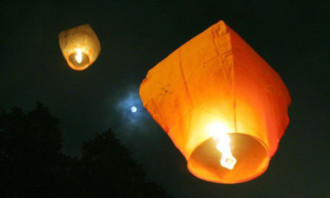Angus Council is not in the party spirit when it comes to Chinese lanterns.
Councillors on the civic licencing committee will be asked to ban sky lanterns and helium balloons from venues with public entertainment licences.
They will hear there is a growing body of evidence that the coordinated release of such party favours causes damage.
The authority’s principal solicitor, David Thompson, has recommended councillors follow the lead of 24 other UK local authorities
Venues or event organisers who allow the intentional release of helium-filled latex balloons and Chinese lanterns will risk fines or the loss of their licence.
Mr Thompson said: “The mass intentional releases of helium-filled latex balloons and Chinese/sky lanterns has increased in recent years.
“These balloons and lanterns pose hazards to wildlife and livestock, causing injury and death.
“Lanterns can also cause injury to humans, damage to buildings and cause false call-outs to the coastguard.”
Once a latex balloon has been released it rises to a height of five miles where the pressure and the temperature cause it to fracture.
The pieces then float back down, but 5-10% do not burst, and float back down whole and partially deflated.
They take six months to degrade and can cause significant harm by entanglement and choking.
Chinese or sky lanterns are made of thin paper held by a wire or bamboo frame and lifted by heat from a naked flame.
They pose similar choking threats to wildlife and livestock as balloons, and they also cause false call-outs to the coastguard.
They pose a fire hazard to dry standing crops, stacks of hay or straw, forestry and farm buildings and thatched cottages.
Recent examples are the recycling plant blaze in the Midlands and a caravan park in Worcestershire, both attributed to lanterns.
In Scotland, NFUS staff and members have reported finding lantern remains on or near farmland in Renfrewshire, Bute, Aberdeenshire, Wigtownshire and near Edinburgh.
Keep Scotland Tidy, the Royal National Lifeboat Institution, the Royal Society for the Protection of Birds and the Marine Conservation Society all support restrictions on the intentional release of helium-filled latex balloons and lanterns.
